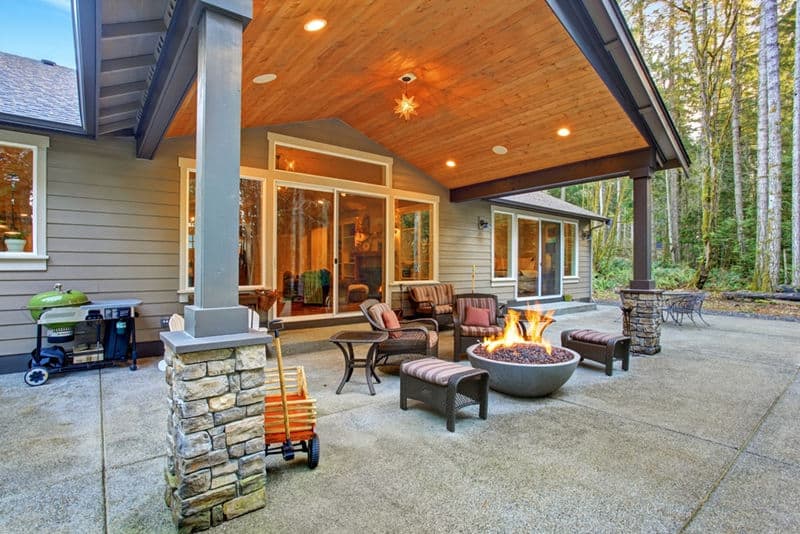A good quality wooden fence should last between ten and fifty years, depending on the type of wood used and normal maintenance. The experts agree that most wooden fences aren’t made using 100 percent treated wood. On the other hand, antebellum homes’ split-rail fences have lasted hundreds of years.
Since many wooden fences aren’t made of treated wood, numerous things dictate whether or not your wooden fence can be saved. What are these things? Why would a wooden fence need replacement?
Related: Types of Aluminum Fences
Rotting
The elements have a bad effect on things left out in them. Moisture, sun, and the wind weaken the wood of fences. This causes rot to set in at the base of the boards closest to the ground.
Even if you treat wood fences with preservatives, it’s only a matter of time before rot will set in.
One rotten board isn’t a big thing; it can be replaced. It’s when you see rotting in several or all of the boards that the fence needs replacing. This can happen in one to six months, if the fence is in standing water, or if the area is hot and humid.
Treated wood close to the ground needs protection as well. It will rot within a few years if the grade of the wood isn’t right.
Termite Damage
Two types of termites love wood fences: subterranean termites and dry wood termites. Dry wood termites live in fence boards above ground. They’re what interests us here.
They’re red with black wings, but you won’t see them. They stay burrowed into the wood because they have no need for soil like subterranean termites.
Because they’re just about invisible, they can remain on your fence for years. Their colonies grow slower than subterranean colonies, so they can inflict serious damage on your fence.
When termites are involved, all homeowners can do is have the fence ripped out and replaced. Make sure you use pressure-treated wood. The treatment sinks deeper into the wood, making it more difficult for termites to feed on it.
Leaning
🏡 Find Your Perfect Town in the USA
Tell us about your ideal lifestyle and we'll recommend 10 amazing towns across America that match your preferences!
A leaning fence’s fenceposts have been weakened to the point that the fence panels tilt a bit. The ground shifts every day due to a wide variety of things, from road traffic to nearby construction to rain. Whatever is stuck into this shifting ground will shift as well.
The panel attached to the shifting fence post can be replaced. However, if panels on both sides of the fence post are leaning, then it’s time to replace your whole fence.
Splintered, Broken, or Missing Fence Boards
Breaks in a fence board stem from the cutting and seasoning of the wood. Wood holds a lot of moisture, so when it’s cut and as it dries, cracks and breaks will appear in the boards. Add to this the fact that the wood will absorb the rainwater, and it will have to dry as well.
This might mean more cracks, breaks, and splinters.
This breaking process will happen just a few days after installing your wooden fence. Pressure from the nails and screws used in installing a wood fence adds to the breaking and splintering. To avoid this, pre-drill holes in the fence and use screws.
They won’t crack a wooden board like pointy nails will.
Boards and fence posts that insist on breaking and splintering no matter what you do will require replacement with pressure-treated wood.
Accident Or Act Of God
A car slamming into your fence, a tree falling on it in a terrible storm, or the fence being picked up and hurled into the atmosphere by a hurricane are either accidents or Acts of God that no fence-owning homeowner can predict. You could enjoy your wooden fence for years before someone makes a Chevy Impala-shaped hole in your fence. That hurricane or vicious storm could happen tomorrow.
Nor is the structural damage to the fence predictable. Homeowners could count themselves lucky if only a couple of panels need replacement. Unfortunately, it happens more often that the whole thing is totaled.
If one part of the whole is damaged, it weakens the rest of the fence. Replacement is the only option.
When Replacement Is Cheaper Than Repairs
We’ve all seen blonde boards among the boards in a redwood fence. The homeowner found repairing a few boards a financially better prospect to replacing the fence. What happens to boards that need repairs more often?
Age and ordinary wear and tear will affect a wooden fence no matter how long it’s been since installation. Homeowners will find themselves repairing the aging boards more and more often. The repair costs add up until replacement is the only option left.
Consult with a local construction contractor when your fence shows signs of damage. He will assess the wood’s condition and recommend either repair or replacement.
Conclusion
While it’s true that wood fences last between ten and fifty years, there are a number of factors affecting the strength of the wood. They weaken it within certain spans of time. One factor such as splintering or breaking boards can take days before needing replacement.
Others might take years, such as catastrophic weather damage. The remedy is to keep the fence well maintained and keep an eye on it for any signs of trouble.
Sources:
Thefenceauthority.com – WHY CRACKS FORM IN WOOD FENCES AND HOW TO AVOID THEM
Texasbestfence.com – 6 Signs It’s Time To Replace Your Fence
Capefearfence.com – How to Identify Termites in Your Wooden Fence | Leland Fence Repair
Allcountiesfenceandsupply.com – 5 Signs that You Need to Replace Your Wooden Fence
Fenceauthority.com – SHOULD I REPAIR OR REPLACE MY FENCE?
🏡 Find Your Perfect Town in the USA
Tell us about your ideal lifestyle and we'll recommend 10 amazing towns across America that match your preferences!














